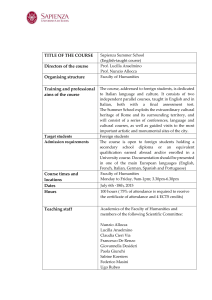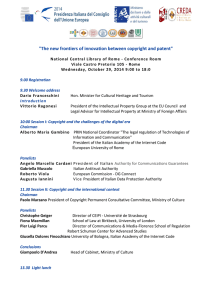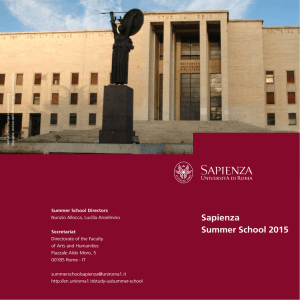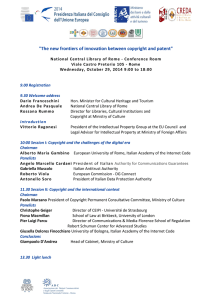soils cities
advertisement
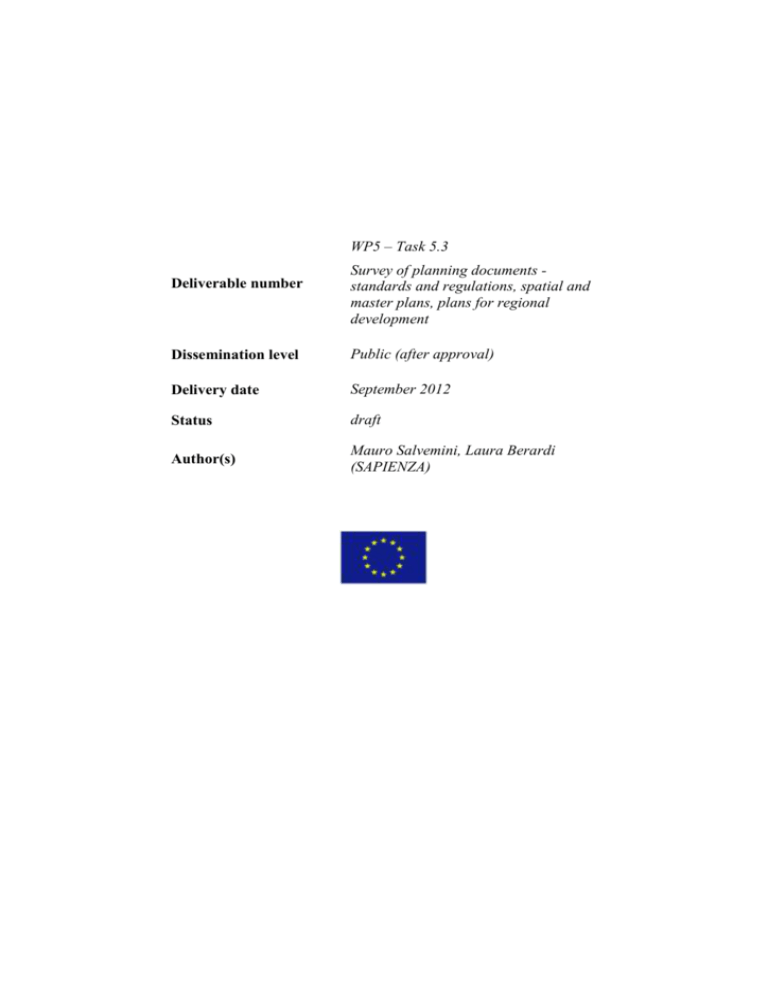
WP5 – Task 5.3 Deliverable number Survey of planning documents standards and regulations, spatial and master plans, plans for regional development Dissemination level Public (after approval) Delivery date September 2012 Status draft Author(s) Mauro Salvemini, Laura Berardi (SAPIENZA) Contents Foreword ........................................................................................................................ 3 1. Scope ...................................................................................................................... 3 2. Introduction ............................................................................................................ 3 2.1 Urban growth in Italy: the historical phases .................................................. 3 2.1.1 The urban suburbs .................................................................................. 4 2.1.2 The metropolitan area ............................................................................ 4 2.1.3 The sprawl in last decades ..................................................................... 5 3. Soil consumption and Italian policies .................................................................... 6 4. Soil consumption monitoring ................................................................................. 8 4.1 The urbanization of the territory, according to ISTAT ................................ 11 4.2 The urbanization of some Italian Cities ....................................................... 12 5. The City of Rome................................................................................................. 14 6. Current Italian actions and final remarks ............................................................. 15 2 Foreword This document has been prepared in the context of Task 5.3 - Survey of planning documents - standards and regulations, spatial and master plans, plans for regional development, whose goal is to survey the national and local legislation/regulations, if any, concerning conversion of rural land and forestry into urban land as well the assessment of their effects on urban expansion and sprawl. The study focuses on Italian situation and especially on the City of Rome in comparison with European context. 1. Scope This document aims to show Italian urban development in recent decades. It describes the urban system evolution: the transition of the city, from consolidated to widespread up to the new metropolitan models, the new suburbs and the consequences of these enlargement patterns. The urban sprawl, the land consumption in Italy and the various actions and policies to study the problem and attempt to contain the trend. 2. Introduction The growth processes that affected the cities all over the world since the industrial revolution until the seventies of previous century are easily identified by the population growth also in Italy. Current Italian situation may be briefly summarised saying that also in presence of negative demographic may be recorded a very large urban growth, which consequently drives an substantial soil consumption. 2.1 Urban growth in Italy: the historical phases From the Italy Unification to the Second World War there are the first major changes of the cities and territory, arising both from new technological discoveries (mobility, energy, environmental health) and the resulting migration of large masses of the population to the big cities, attracted by the job opportunities, resulting exodus from the countryside, which has since suffered a decline still today in progress. The major Italian cities - Turin, Milan, Genoa, Bologna, Florence, Rome, Naples, Bari, Palermo - grow to take in new inhabitants. The period between both World Wars is crucial for this development phase. Fascism deals with the urban issue and heavily tries to contain the exodus from the countryside with a series of measures. It is also founding new towns and rehabilitating large regional areas promoting the agricultural activities. The reconstruction at the end of World War gives rise to large cities suburbs development. In the decade 1945-1955 Italy acts on the old and established centers of the cities, according to the Marshall Plan (1947), using a new planning regulation, the 3 Piano di Ricostruzione (Legislative Decree 154/45 and National Legislation 1402/51), with simplified procedures, in place of the newborn Piano Regolatore Generale and its implementation plans, introduced by the Legge Urbanistica Nazionale on 1942 during the Fascit period. The first suburbs begin to arise in these years for the influence of emigrants who leave villages and small towns of central and southern Italy, where the war has largely destroyed the remaining rural economies, and who increasingly see the big city life chances. 2.1.1 The urban suburbs In the mid-century in the Italian cities, the new districts arise more or less before the draft and approval of the first municipal urban plans. In addition there are the first "spontaneous" settlements, generally barracks or slums, on the edge of town, where those who can not access housing in both new and old neighborhoods are located. On the previous agricultural land, without following any planning regulations, there is the increasing of parcels and the subsequent sale of individual lots. Everything is in the hands of private developers who owned agricultural land or have been particularly smart to buy large spots on the beginning of the phenomenon. This phenomenon characterized all Italian large cities. Because this the self-helping construction immediately started, land lord of small parcel started to build their own house sometime working only during the week ends. Regulations have been completely ignored and Municipalities demonstrated their own weakness not having any power in planning and controlling. It is amaze that these houses obtained all the service facilities by private and public companies (gas, water, telephone). The new illegal construction areas have been formalized only after many years, in the Region Lazio, for example, with the Regional law of 1980 providing public and private requalification actions at total community expenses. Once the suburbs were seen as "the outermost and marginal zone, as opposed to center, to a space or a territory", presently there are not more boundaries of these, it is no longer the outer area of the city or it has been named the last boundary between town and country. We are witnessing an expansion of the city in the direction of "widespread metropolis" with a slow but steady erosion of ex agricultural areas, with suburban areas that are currently enclosed in the urban and metropolitan development. 2.1.2 The metropolitan area The metropolitan phenomenon could be associated with the following three different scales: 1) urban areas characterized by continuity in urbanization area and deficiency of enclosed rural areas; 2) metropolitan areas, where functions are integrated and create major exchange flows, typically dependent on the presence of a metropolitan area, which in the case of Rome city is characterized by national government settled together with all related activities; 3) metropolitan regions, which also include external areas affected by economic influence of urban and metropolitan areas or of other structures (airports, harbors, etc.). Based on an analysis the decentralized poles which were formed externally to the central pole for the high value of central urban soils and for the expulsion of many people towards areas where living costs is lower; there is no longer spatial continuity 4 as constitutive factor of the metropolitan area: the evolution of the urbanization processes, in fact, makes less important the above concept due to fragmentation within the metropolitan area and commuter phenomena across the physical boundaries of the urban area. In Italy and specifically in Latium Region it is geographically confirmed that the metropolitan area is an urban structure with a relevant population, consisting of a large city or metropolis and of its surrounding area. The metropolitan area boundary is hard to define, because the continuous urban development outwards makes problematic the determination of physical limits the associated urban functional processes. It has also to be taken into consideration that according to Italian definition the metropolitan area is a sum of territories under the jurisdiction of several cities (Comuni) more than the principal city which generally gives the name to the metropolitan area. The granularity of Comuni’s dimension varies considerably and also the urbanization characteristics of them are different according to the different location within the metropolitan area. In Italy, the first attempt to define metropolitan areas by border definition was carried out on 1970. The study aimed to define the territorial and economic dimensions of the Italian metropolis, identifying development for decades to come. In 1987 the first Italian study that uses flows commuters as the basis for metropolitan systems definition, survey that had been carried out for the first time in the Census of 1981 by ISTAT (Italian National Institute of Statistics).1 The act passed on 1990 about metropolitan areas substantially did not produce until now any effect in terms of metropolitan management. This may explained by the fact that almost all individuated metropolitan areas overlapped the borders of the Province containing the major city. In the case of Rome the individuated and de facto consolidated metropolitan area overlaps the Province of Rome which is an already existent public authority with its specific mandate and power. 2.1.3 The sprawl in last decades The areas outside the urban centers suffered major transformations in recent decades. In these areas, called peri-urban, the landscape assumed in fact very different characteristics both from the towns and from the rural areas primarily used for agriculture. Territories having no real landscape values (eg protected areas, special areas of conservation, wetlands, etc.) and degraded sites, which are often the ordinary landscapes in which live most of the people, long overlooked and almost designed as sites where there is no real design and planning towards their requalification and valorisation.2 If the first urbanization was expressed as geometric growth of the urban centre, today the remaining territory is strongly interested mainly through the residential, In this context Prof. M. Salvemini, on February 1991, realised a study “Considerazioni territoriali sulla Legge 142/90 sull’ordinamento delle Autonomie Locali ed elaborazioni tramite Sistema Informativo Territoriale di dati statistici ad essa relative”. The scope of the published document is mainly concerned with a quantitative analysis of the possible scenarios subsequent to the implementations of the 142/90 Act on Local Authorities. 2 S. Benni et al, Lettura ed interpretazione dei caratteri dello spazio periurbano, Agribusiness Paesaggio & Ambiente -- Vol. XI (2007) n. 2, March 2008 1 5 commercial or industrial development and transport infrastructure construction. These processes ensure that more or less extensive portions of the extra-urban territory are often considered as a resource to be served to the pressing needs of cities and the consequent soil demand for urbanization even at remarkable distances from their centres. At the core of this transformation, there is also a substantial change in lifestyles and technological processes that previously always affected the dispersed settlements. Today, on the contrary, the problem of distance produced by urban sprawl, with the advent of car ownership, it is very small. In Italy, as in other European countries, is more and more urgent to study the dynamics of urban growth, then the analysis and quantification of land use transformations, of soil consumption, of demographic pressure and the related development trends, particularly in the periurban territories. 3. Soil consumption and Italian policies The growth of urban areas, with the conversion of the previous destinations of use (agricultural, forest, etc.), is a process that, in Italy, seems unstoppable and invades rural landscapes. Since the seventies, in Italy and in Europe, the growth of urban areas, which up to that time corresponded to a parallel increase of the population, continues despite a stabilization of the population. The portion of land with artificial covering in Italy is estimated at 7.3% of the total, compared with 4.3% of the EU average, and the incidence of artificial covering amounts to 204 inhabitants per km2, compared to an EU average of about 120.3 Soil protection is one of the key of spatial policies and represents a major factor in spatial planning. Although this issue at the international level has been taken as an urgent priority, in Italy there are still no dedicated regulations to this direction, such as physical planning tools, from the strategic to a wide area to the local one. Generally speaking the master plan of a city requires a general description of the geological and environmental situation of the territory of the entire Comune but does not limit building regulations to idro-geological threads. For sake of clarity it has to be said that this is varying from Region to Region according to the fact that according to National Constitution each Region is ruling and regulating his territory according to specific regional acts. Under the "Sixth Environment Action Programme", the European Commission adopted in 2006 a " Soil Thematic Strategy", which aims to establish a framework of rules to the prevention of deterioration and to preserve the ecological, economic, social and cultural soil. Key element of the strategy is the proposal for “Soil 3 LUCAS (Land Use/Cover Area frame Statistical Survey) survey conducted at European level by Eurostat for comparing the general characteristics of cover and land use in 2009 in 23 European countries (all EU members except Bulgaria, Romania, Malta and Cyprus), and between the different Italian Regions, through direct observation of selected points on the territory from a fine spatial grid (2km). 6 Framework Directive", under examination, which will allow Member States to adopt appropriate measures to individual local conditions. As mentioned before the Italian legislative framework, despite the amendment of Title V of the Constitution (2001) stipulates that the territorial government is regulated in concurrence between State and Regions, does not provide for specific measures on the soil consumption issue. In the Italian rules soils are not considered as limited natural resources and therefore subject to a specific regulation that provides for the conservation and protection. There are regulations of protection to meet specific needs, such as those related to the hydro-geological prevention or the protected areas safeguard, but there is no a discipline that enhances the soil itself. The few examples of Italian laws enacted in the last years that take into account the control of soil sealing in the parameters that should govern the growth and the transformation of the urban space come from the following Regions, although the actual effects seem limited:4 - Emilia-Romagna: Regional Law 20/2000, - Umbria: Regional Law 1/2004, - Tuscany: Regional Law 1/2005. Currently in Italy exists the National Observatory on the soil consumption (Centro di Ricerca sui Consumi di Suolo – CRCS, http://www.consumosuolo.org), enabled in 2008 by INU (Istituto Nazionale di Urbanistica), Legambiente and the Department of Architecture and Planning at the Politecnico of Milan, with the main objective to collect and elaborate data on the urbanization process of soils in Italy, according to reliable and shared methods of analysis and evaluation. CRCS identified a methodology for the quantitative definition of soil consumption at the Local level (Provincia) which is based on research related to land use mapping on at least two distinct periods (separated by thresholds reasonable time to observe the change). This geographic data should be observed using a map database (vector or raster) showing the land uses and land cover at a scale 1:10,000. The soil consumption measurement is based on the observation of changes occurring between the different surveys of land use. The research results are presented in an Annual Report. The First Report of 2009 highlights the lack of a National work program on the land consumption monitoring and of a shared method with which to carry it forward, due to the limited updated, reliable and comparable data on what soil is 'consumed' and transformed. The Italian Regions which, to date, have maps of land use on different time thresholds and realised with the same comparable methodology are very few, such as: Lombardy, Emilia Romagna, Friuli Venezia Giulia and Sardinia. 4 Di Fabbio, A., Di Leginio, M., Giordano, F., Guerrieri, L., Leoni, I., Munafò, M., Viti, S., 2007. Impermeabilizzazione e consumo dei suoli nelle aree urbane, Ecologia Urbana, XIX (2), 2007. 7 4. Soil consumption monitoring The development of the main dynamics of land cover and land use changes in Europe shows the gradual decrease of agricultural areas in favor of artificial areas. Thus the urgency of the phenomena monitoring and the understanding of the urban dynamics causes further increases. Understanding urban dynamics is one of the most complex tasks of sustainable urban planning. Numerous studies have been developed in order to assess this phenomenon, both at the European (e.g. LUCAS, Corine Land Cover, ...) and Italian (by entities such as ISPRA, ISTAT, AGEA) level. The current dynamics of the urban process, in the absence of a concrete management of the landscape and environmental heritage, are in line with the desertion of countries and the invasion of warehouses, infrastructures and "secondary residences". These trends lead to the loss of agricultural areas of high environmental and cultural value. According to the data of the Corine Land Cover, nearly 90% of the land use changes occurred in Italy between 1990 and 2000 was due to loss of agricultural areas for artificial areas and forests and semi-natural environments. More than 80.000 ha of Italian territory were "artificialized" through the new residential, industrial and commercial areas construction as well services, extractive areas, roads, railways, etc.5 Although the residential areas had the greatest expansion (in Italy more than 500 square kilometres of land per year are consumed on average), the industrial, commercial and infrastructural areas are that which had a greater percentage increase (10.7%). The soil sealing development is largely attributable to Italian spatial planning strategies that have not taken into account the irreversible loss of soil, together the environmental effects, the quality of the resource sacrificed and the existence of tools able to assess it. According to the Legambiente annual report "Ambiente Italia 2011"6 realised by the Istituto di Ricerche Ambiente Italia7 the estimated data are as follows: urbanized areas = 2.350.000 ha = 7.6% National territory 415 sqm per inhabitant In 2010, the CRCS has detected the soil consumption in the Italian Regions, showing the following percentages of the artificial surfaces compared to their territorial extension: - Lombardy : 14% - Veneto : 11%, - Campania : 10.7% - Lazio and Emilia Romagna : 9%. 5 Maricchiolo, C., Sambucini, V., Pugliese, A., Munafò, M., Cecchi, G., Rusco, E., 2005. La realizzazione in Italia del progetto europeo Corine Land Cover 2000, Apat, Rapporti 61/2005, Roma. 6 http://www.edizioniambiente.it/eda/catalogo/libri/571. 7 http://www.ambienteitalia.it 8 Emilia Romagna Region: the soil consumption from 1949 and 2008. According to the survey of FAI (Fondo Ambiente Italiano) and WWF, it has reached a speed of 9 hectares per day. [image produced by Bernardino Romano - FAI album] Lazio Region: the soil consumption from 1949 and 2008. One of the Italian Regions most affected by unauthorized building. [image produced by Bernardino Romano - FAI album] 9 The first CRCS results have, however, shown that, in addition to the just mentioned situations, the Molise, Puglia and Basilicata Regions, though maintaining a strong rural character, are seeing accelerated growth dynamics of urbanized areas. Most of the changes takes place on agricultural soils, and in a lesser extent at the expense of uncultivated land or forestry, consistent with that observed in the rest of Europe. The city of Bari: the soil consumption from 1949 and 2008. The city of Bari and expanding like wildfire inland. In Puglia Region, the increase construction has a rate of 7%. [image produced by Bernardino Romano - FAI album] Urbanization increases mainly at the expense of the agricultural areas, that in Italy decreased by more than 140,000 hectares in 10 years. The conversion of non-irrigated crops into urban land (sparse and discontinuous buildings) for more than 17,000 hectares, and from rural areas with complex farming systems more than 16,500 hectares. More than 15,000 ha also the transformation of non-irrigated crops in industrial or commercial areas. The phenomenon of urbanization is most evident in the North where almost half of the areas that have become artificial while leaving agriculture and growth of natural areas are larger in the South, with 70,000 hectares of ex-farmland now used differently and 40,000 hectares of new natural or semi-natural areas. (see note 4) 10 The rural land "abandoned" does not necessarily turns into artificial areas: in fact, from 2004 to 2010, 4.6% of rural land changes, of which only 0.9% is for use / cover artificial and the remaining 3.7% is transformed instead into natural area.8 The urban sprawl is particularly evident on the Italian coast. In the last decade, there has been a very consistent increase of soil sealing, with percentages even higher than 60% in the province territory of Viterbo, Matera, Catania, Siracusa, Macerata, Ascoli Piceno, Udine and Brindisi and with high percentages also in Sicily, Marche, Abruzzo and Puglia Regions. Change in urbanized areas between 1975 and 1992 in the coastal area of 10 km. [APAT / CTN_TES processing on data Lacoast]. 4.1 The urbanization of the territory, according to ISTAT The above described has been confirmed and deepened in a study of ISTAT (Italian National Institute of Statistics) on the basis of censuses of 2001 and 2011, through the mapping of the inhabited areas9 perimeters of the two censuses in comparison. (see note 5) In 2011, of 20,300 sqkm used from the all inhabited areas, just over 17.500 sqkm are occupied by towns, whose surface increased by nearly 1,200 sqkm (+7.1%) compared to 2001. The remaining 2,700 sqkm include small settlements or manufacturing lands and infrastructures, the latter two types, although quantitatively less important compared to 2001 increased respectively by 16.9% and 29.1%. The statistical data analysis on building permits, carried out by ISTAT, allows to 8 Le problematiche connesse al consumo del suolo. ISTAT, Rome, January 18 2012. Areas of land on which there are houses clustered in towns (characterized by the services presence) and settlements, with scattered houses, or manufacturing areas outside the city. 9 11 provide some information on the evolution of buildings pressure on Italian territory. In the fifteen years from 1995 to 2009, the Italian municipalities issued building licenses for a total of 3.8 billion cbm (over 255 million cubic meters per year), of which more than 80% for the new buildings construction (the remaining for the existing buildings extension), and just over 40% for residential buildings. The origin of the overall demand trends could be recognized in the demographic influence, in the policy decisions, in particular the building amnesties of 1994-1995 (National Law n. 724 of December 23 1994, n.) and 2004 (National Law n. 326 of November 24 2003), as well as the general economic trends. The trends has been as following referred the building type: - non-residential: more than new 200 million cbm early of the last decade, after which the demand for productive activities has remained stable at around 150 million m3 per year, up to a clear fall in 2009, as a result of the crisis. - residential: the expansion phase continued until 2005, with a maximum of about new 131 million m3. Then, the demand decreased to 75 million m3 in 2009. In the last year, some local rules of the "house plan" helped to contain the fall in the residential sector activity and together contributed to a increase in licenses issued for existing buildings extensions, up to 29% of the total. Housing demand compared to demographic change (2001 and 2009): new housing licenses increased by 6.7%, the population increased by only 5.3%, however, the the number of families is increased by 11, 5%, with a substantial contribution of the foreign population. The soil consumption is not homogeneous on the whole national territory, both for morphological issues, both for reasons partially caused by the different economic capacities and, also, by the presence of second and third homes. In 2011, the Italian population is divided into 61,508 inhabited areas, of which 21,730 towns.10 Compared to 2001 the whole of the inhabited areas increased by 1,7% and the towns of only 0.3%, due to the expansion of existing inhabited areas and the mergers occurred between them (about 1,500). In the Center-North, in fact, the land use is implemented mainly through the expansion of existing locations or fusion between adjacent locations, while in some regions of Southern prevailing tendency to create new inhabited areas. 4.2 The urbanization of some Italian Cities In the last decades population are moving from the larger cities towards new settlements expansion. The soil consumption has enlarged, therefore, on the surrounding minor municipalities, removing progressively rural and / or natural land. At the same time, new residential areas in previously production areas. Strengthens the concept of "moving border" and there are new houses also to a considerable distance from the workplace. (see note 5) ISTAT made an historical analysis starting from the census of 1951 on 13 large 10 Please note that at June 30 2011 the official number of Italian Municipalities amounted to 8092 (source ISTAT), and the data, in this case, refer to the inhabited areas 12 municipalities: Turin, Milan, Genoa, Venice, Bologna, Florence, Ancona, Rome, Naples, Bari, Reggio Calabria, Palermo and Cagliari. The analysis showed the gradual loss of population in the 13 largest municipalities in favor of neighboring municipalities: the total resident population in large cities compared to the total area, from 1951 to 2010 decreased from 70.3% to 56%. The trends are different among the cities: for example the decrease is particularly relevant to the municipality of Milan, whose impact on the resident population of the area goes from 82, 2% in 1951 to 55.4% in 2010. However, new urban development does not match the actual houses request. In Naples and Milan, in 2007, the impermeable surfaces covering the 62% of the municipal land. Nevertheless, compared to about 4 million houses built in the last 15 years, in large Italian cities at least 200,000 families have no access for financial problems. In the same city of almost one million houses are empty because economically unreachable by those who would need.11 Number of empty houses in 2009: - Rome : 245.142, - Cosenza : 165.398, - Palermo : 149.894, - Turin : 144.398, - Catania : 109.573. The city of Milan: the soil consumption from 1949 and 2008. The city continues to increase despite the emigration of thousands of residents to other areas. [image produced by Bernardino Romano - FAI album] 11 Ambiente Italia 2011 dedicato al consumo di suolo, Legambiente press release. 13 The city of Cagliari: the soil consumption from 1949 and 2008. [image produced by Bernardino Romano - FAI album] 5. The City of Rome In Rome, opposed to many other European cities, missing a clear limit between the urban and the rural areas, distinctly bounded by what are called greenbelts. These represent areas of limit clearly defined according to Municipal Urban Planning (Piano Regolatore Generale), of the city development at the expense of the various types of green areas. In Rome, however, the “Piano certezze” approved in 1984 to establish definitively the areas to be allocated to urban development and those to maintain for rural and green uses. But the zones for rural use by the aforesaid Plan do not really have remained untouched over 16 years. Converted areas marked in red. [image provided by City of Rome] 14 In recent years, the city of Rome area has seen an massive expansion building, and because the city of Rome is the largest in Italy in terms of area and population. One study on the soils transformations into urban uses in Rome among 1993 and 2008 reveals that, in 15 years, they increased by 12% (4,800 hectares, almost three times the "historical " city included within the Aurelian Walls). During the same period, the population increased by 30,887 inhabitants, with an average of 150 square meters of soil transformed for each new inhabitant. The transformation particularly affected rural soils (Rome is the largest rural area in Europe) but also major portions of natural areas. 4,384 hectares of agricultural land moved out, 13% of the total and 416 ha of forest land. Currently, according to planning regulations in force in Rome and programs in place, it is expected a further consumption of 9,700 acres, mostly agricultural, which is more than it has been transformed between 1993 and 2008. (see note 7) Last but not least, to denounce the continuing critical situation in the City of Rome, were some environmental groups. In fact in the past months the City of Rome Authority launched a call to identify some areas for social housing development. The current prevision: 135 areas expected in 1,900 hectares, with 20 million cubic meters. Numbers higher than those of the real housing needs, which had been estimated in 27,500 housing now become more than 60,000.12 6. Current Italian actions and final remarks The Italian critical situation, which have registered between 1956 and 2012 an increase of 166% of the built area corresponding to a reduction of 28%, from 70 years, of utilized rural area (5,000,000 hectares), has led the Italian Government to put measures. If it is true that of such 5,000,000 of rural area about 70% has been abandoned, so that, except in the case of valuable crops, the forest has regained territory, there is anyway to record that the other 1.5 million hectares was covered with small single houses , sheds, interchanges, roads, pylons and landfills. 12 “Housing sociale è allarme cemento”. REPUBBLICA, Italian newspaper, July 05 2012 15 According to ISTAT the built-up areas cover 6.7% of the national territory. [image published by REPUBBLICA, Italian newspaper, September 15 2012] Which role did urban planning have in this process? The urban master and specific plans accompanied this approach: the soil market value increases only if estate planning regulations provide the building destination. This situation has been in place until the 80s early 90s. In Italy there is a building process that is radically disengaged by the urban planning regulations because both it done, in large part, an exception to PRG (Piano Regolatore Generale) in force and it takes as reference a landscape planning currently being rewrite, not yet adapted to the requirements and objectives established by the Code of Cultural Heritage and Landscape (Legislative Decree no. n. 42/2004). Needless to, however, that the soil consumption is one of the component of urban planning management that continues to have as reference the National Planning Law of 1942, now largely outdated and unworkable both from the point of view of time and from that of the legal framework of reference.13 The current Government (2012) is moving in the defence of the landscape direction. On September 14 2012, the Italian Government adopted the draft law aimed at "developing the rural areas and the containment of soil consumption". It mainly involved: establishing at the national level, the maximum extension of rural land for conversion in building land (those soils whose land-use can be adapted by planning regulations). The aim is to ensure a balanced development of spatial planning and a balanced distribution between the area subject to rural use and building areas. The Regions, in turn, establish it at regional level and distribute it between Municipalities; establishing a National Committee for monitoring the rural land consumption in Italy and the use transformation of rural land; introducing the prohibition of changing the land-use of rural land that used National or European funding for at least five years; 13 TERRA RUBATA. Viaggio nell’Italia che scompare. 2012, FAI and WWF Dossier. 16 promoting the rural housing recovery to facilitate preservation, renovation and restoration of existing buildings, rather than the building and construction activity of new urban areas; introducing a Registry in the Ministry of Agriculture in which the concerned Municipalities, where the planning regulations do not include the increase in building area or an increase below the threshold, can ask to be placed; abrogating the rule allowing the building contributions are partially removed from their ordinary purpose - which is to contribute to the costs of the primary and secondary urbanization works - and are addressed to running costs by the local authority. TURaS “For land use we mean the change in coating of permeable soil for the construction of buildings, roads and other uses. uses The land use is a measure of progressive cementation and sealing due to the expansion of urban areas at the expense of agricultural and natural lands”. Source: VI Italian Report on Urban Environmental Quality (ISPRA, ARPA, APPA) Urban Sprawl DATA MODELS LAND CONSUMPTION “The land consumption must be considered as a dynamic process that alters the soil nature, from natural conditions to artificial conditions. The soil sealing is considered the last stage. It affects land uses that involve the loss of natural characters, producing an artificial surface.” Fonte: European Environment Agency (EEA); 2004 How many things would change with INSPIRE… TRANSITIONING TOWARDS URBAN RESILIENCE AND SUSTAINABILITY Some draft final considerations have been presented for further discussion and research. They may be summarised in the above slide which has been presented and discussed in Rome, last 14 of March 2012, “INSPIRE: prepararsi all’atterraggio”14 national Workshop where the Ministry of Environment was actively present. The slide is demonstrating that according to the two definitions of Soil Consumption there are two different visions of that. The one from EEA outlines that the soil sealing is the final phase of a process which has to be monitored carefully since the beginning and continuously, the Italian definition of the legal entities managing the environment, on the other end, is defining the soil consumption as the result of the process which is building man-crafted objects on a previously permeable considered soil. 14 http://www.isprambiente.it/it/archivio/eventi/anno-2012/5759-inspire. The programme details and presentations are available on http://www.amfm.it/eventi/2012/INSPIRE/WS_2012-03-14.php 17 The difference is much more than thin considering the speed of the building process, the inertia of public administration, the threads of illegal building and the aggression to protected areas. The two (EEA and Italian) definitions influence also very deeply the data models, required by INSPIRE Directive, to be used in SDIs for monitoring and comparing data. This issue should enter in the TURAS project and his follow-up considering his relevance. 18
